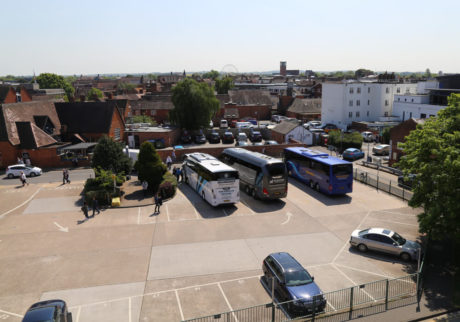Kieran Graham
Read More
Very professional courses. Great Administration assistance and high quality e-learning service.
Sarah Jennings
Read More
I did forex trading diploma. Very professional and detailed course.
Jordan Cooke
Read More
The course offered is excellent. I am glad to have taken it.














Transport in the United Kingdom is facilitated with road, air, rail, and water networks. A radial road network totals 29,145 miles (46,904 km) of main roads, 2,173 miles (3,497 km) of motorways and 213,750 miles (344,000 km) of paved roads. The National Rail network of 10,072 route miles (16,116 km) in Great Britain and 189 route miles (303 route km) in Northern Ireland carries over 18,000 passenger and 1,000 freight trains daily. Urban rail networks exist in Belfast, Birmingham, Cardiff, Edinburgh, Glasgow, Leeds, Liverpool, London and Manchester. There are many regional and international airports, with Heathrow Airport in London being one of the busiest in the world. The UK also has a network of ports which received over 558 million tons of goods in 2003–2004.
Transport trends
Since 1952 (the earliest date for which comparable figures are available), the United Kingdom saw a growth of car use, which increased its modal share, while the use of buses declined, and railway use has grown more slowly. However, since the 1990s, rail has started increasing its modal share at the expense of cars, increasing from 5% to 10% of passenger-kilometres travelled. This coincided with the privatisation of British Rail, but its impact is heavily debated.
In 1952, 27% of distance travelled was by car or taxi; with 42% being by bus or coach and 18% by rail. A further 11% was by bicycle and 3% by motorcycle. The distance travelled by air was negligible.
By 2015 83% of distance travelled was by car or taxi; with 5% being by bus and 10% by rail. Air, pedal cycle and motorcycle accounted for roughly 1% each. In terms of passenger-kilometres, slightly over 662 billion were made by cars, motorcycles vans and taxis, 78 billion by rail, 39 billion by bus, 5 billion by pedal cycle and 9 billion on domestic air flights.
Passenger transport has grown in recent years. Figures from the DfT show that total passenger travel inside the United Kingdom has risen from 403 billion passenger kilometres in 1970 to 793 billion in 2015.
Freight transport has undergone similar changes, increasing in volume and shifting from railways onto the road. In 1953 89 billion tonne kilometres of goods were moved, with rail accounting for 42%, road 36% and water 22%. By 2010 the volume of freight moved had more than doubled to 222 billion tonne kilometres, of which 9% was moved by rail, 19% by water, 5% by pipeline and 68% by road. Despite the growth in tonne kilometres, the environmental external costs of trucks and lorries in the UK have reportedly decreased. Between 1990 and 2000, there has been a move to heavier goods vehicles due to major changes in the haulage industry including a shift in sales to larger articulated vehicles. A larger than average fleet turnover has ensured a swift introduction of new and cleaner vehicles in the UK.
Air transport
Air transport in the United Kingdom is the commercial carriage of passengers, freight and mail by aircraft, both within the United Kingdom (UK) and between the UK and the rest of the world. In the past 25 years the industry has seen continuous growth, and the demand for passenger air travel in particular is forecast to increase from the current level of 236 million passengers to 465 million in 2030. One airport, London Heathrow Airport, is amongst the top ten busiest airports in the world. More than half of all passengers travelling by air in the UK currently travel via the five London area airports. Outside London, Manchester Airport is by far the largest and busiest of the remaining airports, acting as a hub for the 20 million or so people who live within a two-hour drive. Regional airports have experienced the most growth in recent years, due to the success of ‘no-frills’ airlines over the last decade.
Rail transport
The railway system in Great Britain is the oldest in the world. The first locomotive-hauled public railway opened in 1825, which was followed by an era of rapid expansion. Whilst the network suffered gradual attrition from about 1900 onwards, and a severe rationalisation in the mid-1960s, the network is again in a position of growth.
Most of the railway track is managed by Network Rail, which in 2016 had a network of 15,799 kilometres (9,817 mi) of standard-gauge lines, of which 5,331 kilometres (3,313 mi) were electrified.
These lines range from single to quadruple track or more. In addition, some cities have separate rail-based mass transit systems (including the extensive and historic London Underground). There are also several private railways (some of them narrow-gauge), which are primarily short tourist lines. The British railway network is connected with that of continental Europe by an undersea rail link, the Channel Tunnel, opened in 1994.
The United Kingdom is a member of the International Union of Railways (UIC). The UIC Country Code for United Kingdom is 70. The UK has the 17th largest railway network in the world; despite many lines having closed in the 20th century it remains one of the densest rail networks. It is one of the busiest railways in Europe, with 20% more train services than France, 60% more than Italy, and more than Spain, Switzerland, The Netherlands, Portugal and Norway combined, as well as representing more than 20% of all passenger journeys in Europe.
In 2016, there were 1.718 billion journeys on the National Rail network, making the British network the fifth most used in the world (Great Britain ranks 23rd in world population). Unlike a number of other countries, rail travel in the United Kingdom has enjoyed a renaissance in recent years, with passenger numbers reaching their highest ever level. This has coincided with the privatisation of British Rail, but the effect of this is disputed. The growth is partly attributed to a shift away from private motoring due to growing road congestion and increasing petrol prices, but also to the overall increase in travel due to affluence. However, passenger journeys have grown much more quickly than in comparable countries such as France and Germany.
Road transport
The United Kingdom has a network of roads, of varied quality and capacity, totalling about 262,300 miles (422,100 km). Road distances are shown in miles or yards and UK speed limits are indicated in miles per hour (mph) or by the use of the national speed limit (NSL) symbol. Some vehicle categories have various lower maximum limits enforced by speed limiters. Enforcement of UK road speed limits increasingly uses speed guns, automated in-vehicle systems and automated roadside traffic cameras. A unified numbering system is in place for Great Britain, whilst in Northern Ireland, there is no available explanation for the allocation of road numbers.
The earliest specifically engineered roads were built during the British Iron Age. The road network was expanded during the Roman occupation. Some of these survive and others were lost. New roads were added in the Middle Ages and from the 17th century onwards. Whilst control has been transferred from local to central bodies and back again, current management and development of the road network is shared between local authorities, the devolved administrations of Scotland, Wales and Northern Ireland and Highways England. Certain aspects of the legal framework remain under the competence of the United Kingdom parliament.
Why the UK is struggling with poor infrastructure
More than 45 metres below the ground in London, almost 10,000 construction workers are racing to complete the capital’s new £15bn Crossrail train line — Europe’s biggest infrastructure project, which is due to open next year.
The largely state-funded Crossrail line is a showcase of Britain’s ability to deliver complex engineering projects broadly to time and budget, but it is a rare bright spot.
Too often, British travellers endure overcrowded and cancelled trains, potholed and congested roads, and capacity choked airports.
Moreover, Britain’s problems with inadequate infrastructure extend well beyond transport. Britain has a housing crisis that is rooted in a chronic shortage of affordable homes, with the Grenfell Tower disaster in June also highlighting how existing provision can be poor.
Meanwhile, the country faces a looming crunch in electricity generation as ageing coal and nuclear power stations are shut down.
The World Economic Forum last year ranked the quality of Britain’s infrastructure 24th in the world, down from 19th in 2006. This puts Britain mid-table among industrialised countries, and towards the bottom of the group of G7 nations.
One problem holding back comprehensive infrastructure improvement, which would boost the economy, notably in productivity terms, is politicians’ apparent infatuation with mega projects.
Successive governments have scrapped smaller schemes while pressing ahead with huge programmes such as the £56bn HS2 railway line between London and northern England, and the £20bn nuclear power station at Hinkley Point in Somerset.
“It’s monument building,” says Bent Flyvbjerg, professor at the Saïd Business School at Oxford university. “Politicians like big projects because they are more spectacular, and they need that to get re-elected. They could spend £1bn on mending potholes, but it would be quickly forgotten.”
Other barriers to infrastructure improvements are a lack of political vision and long-term strategy, say experts, as well Britain’s bureaucratic planning system.
But the biggest single issue is lack of funds. Following the financial crisis, David Cameron’s coalition government of Conservatives and Liberal Democrats embarked on an austerity programme that involved slashing investment spending to help reduce public borrowing.
After winning the 2015 election, the Tories announced that they would increase capital spending sharply.
Theresa May’s government set out plans last December for £500bn of infrastructure projects, ranging from broadband to sewers.
But, even if delivered in full, these schemes, which imply investment averaging 2.8 per cent of national income each year, would be substantially below the OECD’s recommendation that countries should spend 3.5 per cent of gross domestic product.
The plans also rely heavily on attracting private sector funding. When ministers unveiled a national infrastructure delivery plan last year, they called on pension funds and other private investors to fund more than half of the schemes proposed by 2021.
But while investors have enthusiastically put equity into existing infrastructure because there is no risk associated with construction, they are wary of new, so-called greenfield projects.
“The big difficulty is in getting investors to take on the risk of major new standalone or bespoke projects”, says Andy Rose, chief executive of the Global Infrastructure Investor Association. “When people talk about a wall of money wanting to invest in infrastructure it is primarily for operating assets.”
Evidence of this stance can be found in how the coalition’s 2010 plan to get pension funds to invest in greenfield projects has so far secured a little over £1bn of the £20bn promised by the then chancellor George Osborne. Nearly all of this has gone on investing in assets that were already built, such as schools and hospitals.
But the current government is not the first to try to persuade the private sector to invest large sums in infrastructure.
Britain was one of the pioneers of the Private Finance Initiative, a model that has now been adopted in many other countries.
First proposed by John Major’s Conservative government in the early 1990s, and then expanded under Tony Blair’s Labour administration, the idea was to deliver infrastructure projects more cost effectively by handing responsibility for building and maintaining assets such as schools and hospitals to the private sector.
However, PFI became discredited partly because of a lack of evidence that private financing, which was significantly more expensive than public funding, provided value for money.
A revamped PFI called PF2 and introduced by the coalition government has delivered fewer projects than industry hoped. Ministers have shown little appetite to make use of the new programme, partly because of the reputational damage to PFI.
Another barrier to private sector investment is the lack of stable, long-term vision from central or local government.
“Cities like Copenhagen, Amsterdam, Berlin and Dublin punch above their weight in attracting institutional investment in infrastructure and real estate because they have a clear vision and strategic plan,” says Lisette van Doorn, chief executive of the Urban Land Institute Europe, a research body.
The UK’s National Infrastructure Commission, established in 2015, is busy devising a 30-year infrastructure assessment, which could form the basis of a long-term strategy for the country.
But the decision by the government not to grant statutory independence to the agency raises questions about ministers’ commitment to establishing politically impartial co-ordination of key projects.
“Government must get much better at prioritising its activities and projects,” said Amyas Morse, head of the National Audit Office, parliament’s spending watchdog, last year. “The government’s portfolio of major projects is enormous . . . I frequently see a ‘muddling through’ . . . A ‘go for it’ heroic effort is prized at the expense of clearly thought-out strategic prioritisation.”
There is no magic pill to remedy Britain’s infrastructure ills, but there are several things the government could do to raise the game of both the public and private sectors.
For example, private investors say that ministers could entice more money from them by identifying proposed infrastructure that will serve as long-term sources of revenue.
“To attract private financing for infrastructure projects, the government or sponsor needs to demonstrate to investors where the future long-term income stream will come from,” says Jonathan Stevens, head of European infrastructure debt at BlackRock.
Meanwhile, experts also say the government needs to engage more effectively with the public to overcome local opposition to projects that could provide wider benefits. This is most apparent at Heathrow airport, London, where politicians have repeatedly changed their stances on expansion.
Analysts also say that ministers must do a better job at assessing whether public or private financing is the most cost effective for infrastructure.
Successive governments have favoured private financing of projects at least in part because it has kept the upfront costs off the public balance sheet.
But some experts argue that the government should take advantage of record-low interest rates to fund greenfield projects through public borrowing.
Chancellor Philip Hammond’s strict fiscal rules, which require the government to cut borrowing to zero by the middle of the next decade, provide a strong incentive to prefer private over public financing.
“The Treasury has a clear preference for privately financing infrastructure projects,” says Nick Davies of the Institute for Government. “But their reasons for that are not well-evidenced and they could and should do more to gather evidence on the costs and benefits of different forms of financing.”
-

Add a note